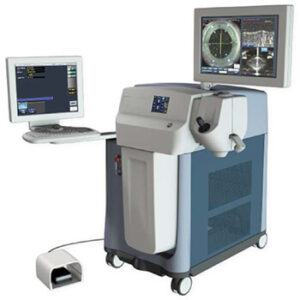Cataract surgery is the only way to treat cataracts. When cataracts affect your vision to the point that they interfere with your quality of life, eye doctors recommend that you have cataract surgery. Cataract surgery removes your cataracts, restoring any vision loss they’ve caused.
There are two different kinds of cataract surgery: traditional methods of the procedure and laser-assisted cataract surgery. Laser-assisted cataract surgery is a more advanced procedure and has several benefits over conventional cataract surgery.
To understand these benefits, keep reading to learn more about cataract surgery and if laser-assisted cataract surgery is superior to traditional methods of the procedure!
What is Cataract Surgery?

Cataract surgery is a procedure that removes cataracts that form on the eye’s natural lens. The only way to do this is to remove the lens itself.
Removing the natural lens is done by creating a tiny incision in the eye and the capsule inside the eye where the lens is located. Your cataract surgeon then inserts an ultrasonic device to break apart the lens and suck up the broken pieces.
When cataract surgery was first invented, this was all the procedure entailed. Patients would have to wear very thick glasses after cataract surgery because their natural lenses were removed from their eyes.
But now, all forms of cataract surgery also include implanting a replacement lens called an intraocular lens, or IOL. The IOL is folded and inserted into the incision, then unfolded and positioned inside the lens capsule.
After that, the procedure is complete! No stitches are needed to close up the incisions as they are small enough to heal on their own.
Traditional Method of Cataract Surgery

Traditional cataract surgery uses small bladed instruments to create incisions in the eye and lens capsule. Cataract surgeons have to be very careful about where they make the incision.
They rely on their knowledge and experience to know the best places to put the incisions. The outcome of traditional cataract surgery is dependent on the quality of your cataract surgery. There’s also some human error, even if your surgeon is very skilled. However, no matter how experienced your cataract surgeon may be, anything unexpected can happen during cataract surgery.
Laser-Assisted Cataract Surgery

Laser-assisted cataract surgery eliminates a significant degree of human error by creating a map of the eye with an imaging device. A computer then analyzes the map to program a laser to create incisions in the eye and lens capsule.
The laser is programmed to make these incisions in the best possible locations. Your cataract surgeon may also use the laser to soften the lens before it’s broken into smaller pieces and sucked away.
This saves time as the lens is much easier to break up after being treated with the laser.
Benefits of Laser-Assisted Cataract Surgery
One of the most significant benefits of laser-assisted cataract surgery is that the procedure eliminates a considerable degree of human error. Cataract surgeons tend to be highly skilled and experienced, but they will never be as precise as a computer.
Since a computer programs the laser used in laser-assisted cataract surgery, it’s much more precise and accurate. The incisions aren’t only made in the optimal location, but they are also cleaner.
The procedure is also quicker, with patients often experiencing a faster recovery than that associated with the traditional method of cataract surgery. The laser is pre-programmed, so it takes less time to make the incisions.
Softening the lens before breaking it into smaller, more manageable pieces saves more time. Because the incisions are cleaner, the eye can heal more quickly.
Laser-assisted cataract surgery can also be an excellent option for patients with astigmatism. The laser can even be used to make limbal relaxing incisions (LRI) that reshape the cornea slightly to correct some degree of astigmatism.
There’s also a certain kind of IOL called a toric lens that corrects astigmatism. Your cataract surgeon at Omaha Eye must place the toric lens precisely inside the eye to work.
A computer programming the laser can help ensure the IOL is placed in the best possible location. This allows patients to achieve better results and the best possible vision.
Who Can Have Laser-Assisted Cataract Surgery?

Laser-assisted cataract surgery is a superior procedure when compared to traditional cataract surgery. However, it isn’t available for every cataract surgery patient.
You can typically only get laser-assisted cataract surgery if you have astigmatism that you want to correct with limbal relaxing incisions or choose a premium lens (including a toric lens) that requires a laser to implant. Premium intraocular lenses are IOLs designed to give patients clearer vision at multiple distances, including up close, far away, and intermediate distances.
These lenses provide patients with better vision than standard monofocal IOLs and may reduce or eliminate the need for reading glasses or other visual aids. Monofocal lenses are the only IOLs usually covered by insurance, as they are medically necessary to preserve or restore vision.
Some patients also choose monovision with monofocal lenses, which allows for better vision than monofocal lenses alone. However, if you select a toric or premium lens, you must pay out of pocket.
With that often comes the option for laser cataract surgery. Astigmatism correcting and premium IOL surgery packages may even include laser cataract surgery.
If you want the most out of your cataract procedure and are comfortable paying for a premium lens, laser-assisted cataract surgery with a premium IOL is worth considering. Want to learn more?
Explore your options by requesting an appointment at Omaha Eye in Omaha, NE, now! Don’t you deserve better vision that you can enjoy for years to come?


